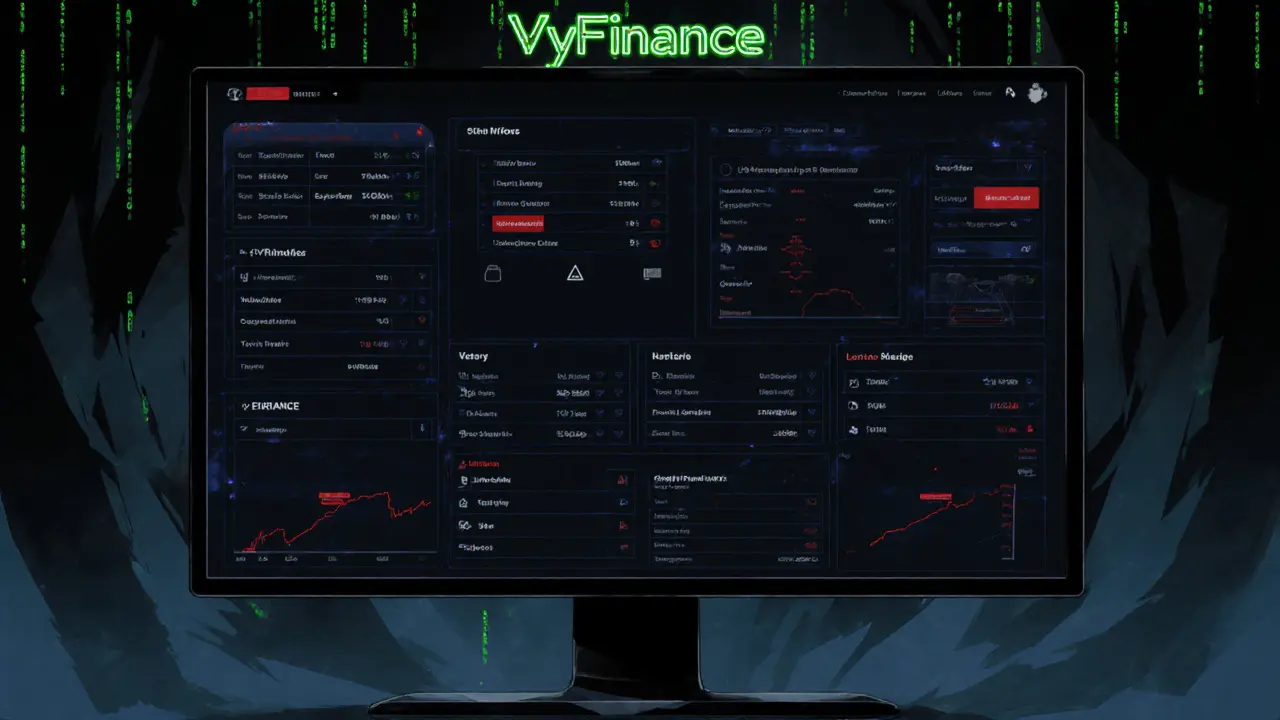VyFinance Exchange Risk Checker
Transparency Issues
VyFinance lacks key information like team bios, licensing details, and fee schedules.
High RiskNo Public Reviews
Zero reviews on FxVerify indicates potential lack of user trust or suppression.
High RiskSecurity Concerns
No published security audits or documentation about protection measures.
High RiskSafe Alternatives
Established exchanges like Binance, Coinbase, and Kraken provide transparency and security.
Low RiskDue Diligence Checklist
- Verify regulatory licensing on official financial authority websites
- Search for independent security audits by reputable firms
- Check community presence on Reddit, Twitter, Telegram, and Discord
- Read user reviews on fraud-moderated platforms like FxVerify
- Confirm transparent fee schedule and withdrawal limits
- Test customer support responsiveness with a sample query
Recommendation
Based on the evidence presented, VyFinance presents significant risks. We recommend proceeding with extreme caution or avoiding it altogether until it provides transparency on team, security, and regulatory status.
Consider safer alternatives like Binance, Coinbase, or Kraken which offer:
- Multiple global licenses
- Transparent fee structures
- Regular security audits
- Active user communities
- Robust customer support
VyFinance review is the kind of deep‑dive you need before you hand over any crypto to a little‑known platform. In this article we break down what little information exists, compare it with the big players, and give you a practical checklist for spotting red flags.
TL;DR
- VyFinance shows zero user reviews and a 0‑star rating on FxVerify - a major warning sign.
- The only public data is the VYFI token price on CoinGecko; no details on fees, security or regulation.
- Established exchanges (Binance, Coinbase, Kraken) offer transparent teams, audits, and active community support.
- Use the due‑diligence checklist below before considering any new exchange.
What is VyFinance?
VyFinance is a cryptocurrency exchange that claims to support trading of its native token VYFI. The platform’s website provides minimal information - no team bios, no licensing details, and no clear fee schedule. Outside of a price ticker on CoinGecko, the exchange leaves a virtual blank space where a transparent operation should be.
Transparency (or the lack of it)
When you search for VyFinance on review aggregators, the only signal you get is a 0‑out‑of‑5‑star rating on FxVerify. FxVerify hand‑moderates reviews to weed out fraud, so a zero‑review count is more telling than a low score - it usually means the platform has not attracted any genuine users or that it is actively suppressing feedback.
Legitimate exchanges pile up reviews quickly, even if they launch in a niche market. Binance, for example, has millions of verified trades and a bustling community on Reddit and Twitter. The silence around VyFinance is a red flag, especially in a sector that has seen countless exit scams.
VYFI Token - the only public footprint
The VYFI token is listed on CoinGecko, where you can see its market cap, 24‑hour volume, and price history. Beyond price monitoring, CoinGecko provides no insight into who runs VyFinance, what security measures protect VYFI holders, or how the token integrates with the exchange’s order book. In short, VYFI exists as a ticker, not as a proof‑point of a functional exchange.

How VyFinance stacks up against the big guys
Below is a snapshot comparison that highlights the gaps you’ll notice when you line VyFinance up with the industry leaders.
| Feature | VyFinance | Binance | Coinbase | Kraken |
|---|---|---|---|---|
| Regulatory License | None disclosed | Multiple global licences | US Money Transmission License | EU & US licences |
| User Reviews | 0 on FxVerify | Millions across platforms | Hundreds of verified reviews | Active community feedback |
| Security Audits | Not published | Regular third‑party audits | SOC 2, ISO 27001 | Annual audit reports |
| Supported Assets | VYFI (only confirmed) | 500+ coins & tokens | 200+ assets | 150+ assets |
| Fee Structure | Unclear | 0.1% taker, 0% maker | 0.5% flat fee | 0.16% maker, 0.26% taker |
| Customer Support | No public contact info | 24/7 live chat | Phone & email support | Ticket system, live chat |
Red flags you can’t ignore
- No verifiable team. A reputable exchange lists founders, advisors, and compliance officers. VyFinance omits this entirely.
- Zero public reviews. Even new platforms gather traction on forums; a blank slate suggests either extreme obscurity or deliberate suppression.
- Lack of regulatory info. In 2025, most major jurisdictions require exchanges to register or obtain a license. No licence data = higher legal risk.
- Opaque fee model. Without a clear fee schedule, you can’t predict trading costs or hidden charges.
- Missing security documentation. No audit reports, no cold‑storage claims, no bug‑bounty program - all typical indicators of a solid exchange.
DIY due‑diligence checklist for any crypto exchange
- Verify regulatory licensing on the jurisdiction’s financial authority website.
- Search for independent security audits; reputable firms like Trail of Bits or CertiK should be named.
- Check community presence - Reddit, Twitter, Telegram, and Discord are good pulse points.
- Read user reviews on platforms that moderate for fraud (FxVerify, Trustpilot, etc.).
- Confirm the exchange lists a transparent fee schedule and withdrawal limits.
- Test customer support responsiveness with a simple query before depositing funds.
Safer alternatives you might consider
If you’re looking for a place to trade cryptocurrencies with confidence, the following platforms consistently meet the criteria outlined above:
- Binance - offers the widest asset range, robust security, and a transparent fee tier.
- Coinbase - best for beginners, fully regulated in the US, and provides clear insurance for custodial assets.
- Kraken - strong focus on security, US‑based compliance, and competitive fees for high‑volume traders.
All three platforms have active development roadmaps, regular security audits, and large user bases that generate real‑world feedback.
Bottom line - proceed with caution
VyFinance currently offers very little beyond a price ticker for its VYFI token. The absence of user reviews, regulatory disclosure, security documentation, and a clear fee model makes it a high‑risk option. Until the exchange opens up its team, publishes audit reports, and gains genuine community traction, it’s wise to stay on the sidelines and stick with established platforms that have proven track records.

Frequently Asked Questions
Is VyFinance a regulated exchange?
No public regulatory licence information is available for VyFinance. In 2025, reputable exchanges usually disclose their licensing status, so the lack of any such data is a warning sign.
What is the VYFI token?
VYFI is the native token associated with the VyFinance platform. It is listed on CoinGecko for price tracking, but the exchange does not provide detailed information about its utility, supply mechanics, or tokenomics.
Why are zero reviews on FxVerify concerning?
FxVerify hand‑moderates reviews for authenticity. A brand‑new exchange typically gathers at least a few verified reviews within months. Zero reviews usually mean either no real users or that the platform is suppressing feedback, both of which raise credibility concerns.
How can I protect myself from exchange scams?
Follow the due‑diligence checklist: verify licences, look for third‑party security audits, read community reviews, test support, and avoid platforms that hide fee structures. Using hardware wallets for long‑term storage also reduces reliance on any single exchange.
Are Binance, Coinbase, and Kraken safe choices?
All three have documented regulatory compliance, regular security audits, transparent fee schedules, and active user communities. While no platform is 100% risk‑free, they meet industry standards for safety and reliability in 2025.


Post Comments (16)
When you’re eyeing a new crypto exchange, the first thing to verify is regulatory licensing; it’s the backbone of consumer protection. Look for clear disclosures on the website about the jurisdictions the platform is authorized to operate in. If the exchange hides this information, treat it as a red flag and consider alternatives. Also, examine the fee schedule – transparency here prevents surprise costs on withdrawals or trades. Finally, test customer support with a simple query before committing any funds.
Exactly, and adding to that, an assertive approach means you should actually place a small deposit to see how responsive the help desk is. A quick reply shows operational seriousness, while radio silence suggests deeper issues. Keep the stake low, but make the test real enough to gauge their process.
The platform’s opacity raises immediate compliance concerns – no KYC/AML framework publicly detailed, which is a non‑negotiable baseline for any regulated entity. In the absence of third‑party audit reports, you cannot assess the cryptographic robustness of their cold‑storage solutions. Moreover, the tokenomics of VYFI remain undocumented, leaving investors blind to supply dynamics and inflation risk. Such gaps in governance and disclosure typically correlate with heightened counterparty risk, especially under the evolving global regulatory landscape.
Picture this: you step onto a stage where the lights are dim, and the audience can’t see the performers’ faces. That’s what trading on an exchange without audits feels like – you’re betting on shadows. The philosophical lesson here is simple: trust must be earned, not assumed. If the architects of VyFinance won’t reveal their blueprints, every trade becomes an act of faith rather than strategy. In the grand theater of crypto, transparency is the spotlight that separates art from illusion.
Hey, I get the excitement around fresh platforms, but the lack of community chatter is concerning :) A thriving Reddit or Discord presence usually signals real users sharing experiences. Without that, you’re navigating blind. Also, the fee model should be publicly posted – hidden fees can bite you later. If you decide to test it, keep the amount small and watch how support reacts.
Sure thing I think transparency is key you should look for a clear fee schedule and licensing info if it’s not there walk away
VyFinance reads like a textbook on how to build a scam – zero reviews, no audits, and an opaque fee structure. It’s a textbook example of a rug pull waiting to happen. Avoid it like the plague unless they magically publish everything tomorrow, which is unlikely.
While the alarm bells are ringing loud, there’s an opportunity to channel that energy into researching proven alternatives. Binance, Coinbase, and Kraken have survived countless market cycles and regularly publish security audits. Leveraging their robust infrastructure gives you peace of mind and lets you focus on strategy rather than survival. Stay vigilant, but don’t let fear paralyze you.
From an African regulator’s standpoint, the absence of any licensing from the Central Bank of Nigeria or other reputable authorities is a glaring oversight. Domestic investors deserve platforms that comply with local AML directives, not shadowy services that ignore jurisdictional mandates. If VyFinance wants to capture the African market, the first step is to publish verifiable licensing documents. Until then, it remains an unsafe proposition for any serious trader on the continent.
yeah i feel you its weird when a site just disappears behind a wall of silence it makes you wonder if anyone’s actually using it
In the vast tapestry of decentralized finance, each exchange is a thread that either strengthens or frays the fabric. VyFinance’s thread appears untethered, lacking the shimmering proof of audits or the comforting glow of community discourse. Without those, the tapestry risks unraveling at the slightest tug of market volatility. The prudent weaver chooses yarn that has been tested, audited, and celebrated across forums, ensuring the fabric remains resilient.
When evaluating any cryptocurrency exchange, especially one as opaque as VyFinance, there is a cascade of considerations that extend far beyond the superficial allure of a new token offering. First and foremost, regulatory compliance serves as the cornerstone of a trustworthy platform; without verifiable licenses from recognized financial authorities, users are essentially entrusting their assets to an entity operating in a legal vacuum. Second, the presence-or conspicuous absence-of third‑party security audits cannot be overstated; independent audits from reputable firms such as CertiK or Trail of Bits provide essential validation of the exchange’s security architecture and its resilience against potential exploits. Third, community engagement acts as a living barometer of credibility; platforms that foster active discussion on Reddit, Discord, or Telegram often exhibit a degree of transparency that is reflected in user‑generated content, ranging from troubleshooting tips to nuanced critiques of fee structures. In stark contrast, VyFinance’s silence across these channels is a red flag that suggests either a nascent user base or a deliberate suppression of feedback. Fourth, a clear and comprehensive fee schedule is vital for traders to anticipate transaction costs; hidden or ambiguous fees can erode profitability and breed mistrust. Fifth, robust customer support-preferably with multi‑channel accessibility and demonstrable response times-serves as the lifeline for issue resolution, especially in the volatile world of digital assets. Sixth, the underlying tokenomics of the native VYFI token deserve rigorous scrutiny: supply mechanisms, distribution models, and utility within the exchange ecosystem must be transparent to assess long‑term value propositions. Moreover, the exchange’s integration with liquidity providers and its ability to handle high‑volume trades without slippage are performance metrics that cannot be ignored. Lastly, it is prudent to adopt a diversified approach: allocating a modest portion of capital to emerging platforms while retaining the bulk of assets on established, audited, and regulated exchanges such as Binance, Coinbase, or Kraken mitigates risk exposure. In essence, a comprehensive due‑diligence checklist-encompassing regulatory verification, security audit review, community sentiment analysis, fee transparency, support assessment, tokenomics evaluation, and liquidity testing-should serve as the prerequisite before committing funds to any platform, and VyFinance, in its current state, falls short on numerous critical fronts.
It is with a certain degree of scholarly disdain that I observe the ongoing adulation of nascent exchanges such as the one under discussion. One must, with the utmost rigor, question the merit of entrusting capital to entities that eschew the elementary obligations of transparency and regulatory conformity. The sophisticates of the financial pantheon would remonstrate that such ventures are more akin to speculative theater than to industrious commerce. Consequently, I advise the discerning investor to refrain from participation until the platform proffers incontrovertible evidence of compliance and security.
Yo, if you’re hunting for a solid spot to trade, stick with the big names that actually show you what they’re doing. VyFinance looks shady, and nobody wants that drama. Keep it simple, keep it safe.
That’s just another hype trap.
While I appreciate the caution, it’s also worth remembering that every major exchange started somewhere unknown; balanced assessment and incremental testing can help bridge the gap between skepticism and informed adoption.